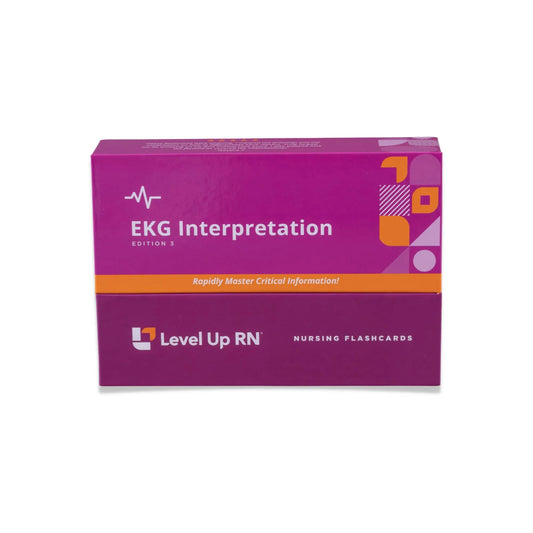In this article, you will learn about the different ventricular dysrhythmias, including premature ventricular complexes, ventricular tachycardia, torsades de pointes, ventricular fibrillation, idioventricular rhythm, as well as asystole. The EKG Interpretation video series follows along with our EKG Interpretation Flashcards, which are intended to help RN and PN nursing students study for nursing school exams, including the ATI, HESI exams, and NCLEX.
As we explained in our article on the natural pacemakers of the heart, a ventricular rhythm is the third backup for the heart. When the sinus node fails to kick off an electrical impulse to make the heart beat, the atrial foci are the first backup, and if that fails, the junctional foci are the next backup, and if that fails, the ventricular foci will take over and create a ventricular rhythm.
The inherent rate of a ventricular rhythm is very slow, between 20-40 beats per minute. The defining characteristics of ventricular rhythms are the lack of P waves and the wide QRS complexes. The QRS complex will be over 0.12 seconds in duration (over three small boxes wide).

EKG Interpretation - Nursing Flashcards
Premature ventricular complexes
This EKG strip shows a premature ventricular complex (PVC). A PVC is an abnormal impulse that originates from the ventricle and occurs early.
Components
The PVC will not have a P wave, and it will have an abnormally wide QRS complex. Remember that the normal width for a QRS complex is under three small boxes wide. You can see in the EKG strip above that the QRS complex is definitely over three small boxes wide
Treatment
PVCs are often asymptomatic and don't require treatments. If a PVC is symptomatic, antiarrhythmics can be used. Antiarrhythmics are one of the key medication classes you will need to know for your Pharmacology exams and they are covered in our Pharmacology Flashcards for nursing students.

Ventricular tachycardia
Ventricular tachycardia is an abnormal, fast heartbeat originating from the ventricles.
Components
The components of a ventricular tachycardia as shown above are missing P waves and wide QRS complexes. In the strip above, you can see that the QRS complexes are regular, so the ventricular heart rhythm is regular. In the strip above, there are 10 small boxes between QRS complexes, and 1500 divided by 10 is 150, so the pulse is 150 beats per minute. Tachycardia is defined as a heart rate over 100 BPM, so we know that this is indeed tachycardia.
Treatment
If the patient has a pulse, then their ventricular tachycardia can be treated with cardioversion or antiarrhythmics. If the patient does not have a pulse, then they should be treated immediately with defibrillation.

Torsades de pointes
Torsades de pointes is a type of ventricular tachycardia that doesn't look anything like a normal EKG strip.
Components
There are no standard P waves or obvious-looking QRS complexes. The QRS complexes are in fact present, but they are abnormally wide and quite irregular (random). They will have an inconsistent appearance.
It may help you to know that torsades de pointes is french for "twisting of the points," because the P wave appears to be twisting around the baseline.
The heart rate shown here is high. You can see between the QRS complexes shown in the strip above, there are only four or five small boxes. 1500 divided by 5 is 300, so you know that this type of tachycardia is occurring.
Treatment
Treatment of torsades de pointes usually includes administration of IV magnesium. Other treatment options include antiarrhythmics as well as pacing. So an artificial pacemaker might be necessary for this patient,

Ventricular fibrillation
Ventricular fibrillation is a heart rhythm disturbance marked by the heart ventricles quivering ineffectively instead of pumping blood.
Components
When you see ventricular fibrillation on an EKG strip, it's difficult to assess the heart rate. There are no P-waves to assess. The QRS complexes are replaced with "v-fib waves" instead. If you see an ekg strip with little bumps as shown above, then that is V-fib.
Treatment
The treatment for ventricular fibrillation is defibrillation. The hint for remembering this treatment is that you should "de-fib V-fib!"

Idioventricular rhythm
Idioventricular rhythm is a slow, regular ventricular rhythm.
Components
In an idioventricular rhythm, there are no P-waves, and a wide QRS complex. Those are your clues that you are seeing a ventricular rhythm. The regularity of the atrial rhythm can't be assessed because of the lack of P waves, but the regularity of the ventricular rhythm can be assessed due to the presence of QRS complexes. In this strip shown above, there are equal distances between the QRS complexes so the ventricular rhythm is regular.
Heart rate
With idioventricular rhythms, the heart rate is expected to be under 40 beats per minute. It is possible to have an accelerated ventricular rhythm, which would mean a heart rate over 40.
Viewing this EKG strip, you can probably guess that the heart rate will be slow. But if you count, you can determine that there are 43 small boxes between the QRS complexes. 1500 divided by 43 is 35, so the heart rate is 35 BPM.
Treatment
Idioventricular rhythms are usually transient and often don't require any treatment.

Asystole
Asystole is the rhythm you never want to see on your patient, but you do want to see on your exam, because it is the easiest one to pick out. It looks the closest to a flat line.
The heart rate is zero. There is no atrial or ventricular heart rhythm. There is no P wave nor QRS complex.
Treatment
If you see an asystole, immediate CPR is needed. Do NOT shock asystole; this is not done, regardless of how often it is shown on TV!
Cathy does like to note that if your patient is upright and talking and you see an asystole, it is likely that their telemetry leads have been disconnected, so use your common sense. If your patient is unresponsive, however, immediately begin chest compressions.


